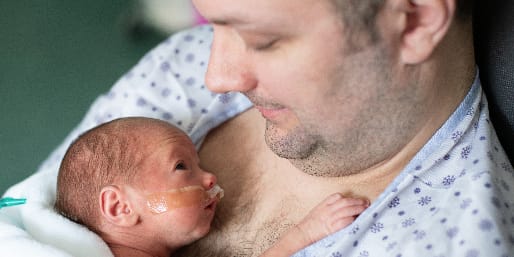Overview
Touch is the first of the senses to develop in the human being and it remains perhaps the most emotionally central to our lives. For preterm infants, positive human touch is not always what they experience due to the medical intervention they require, yet we know that touch is often essential for a new-born's survival. So how can we ensure that this is what these vulnerable premature babies are still able to experience?
What is skin to skin contact (SSC) and why does it matter?
Skin to skin care (SSC) is prolonged & continuous skin to skin contact between a parent & their new-born, low birth weight infant both in hospital & after early discharge, with (ideally) exclusive breastfeeding, & proper follow up post-discharge1.
Who can benefit from skin to skin care?
While most babies can benefit from the many positive effects of skin to skin, it’s particularly powerful for premature babies. Please note, that certain premature babies will not be suitable for skin-to-skin care.
When can preterm babies start Skin to skin contact?
There’s no ‘one size fits all’ here. Skin to skin contact generally depends on baby’s medical stability. Currently, the recommendations are for infants born less than 27 weeks, it is based on individual medical assessment. For infants born 28-31 weeks gestation, then is it usually okay to trial immediately after initial assessment/stabilisation, as long as the baby doesn’t have any other underlying conditions that may preclude the ability to do skin to skin contact. For those babies born at greater than 32 weeks gestation, then it can begin, following initial infant assessment, in the delivery room. Those on ventilation can also try SSC following stabilization and with monitoring and observation2.
Skin to skin contact with a baby has been shown to be beneficial until the infant is 15lb weight (6.8kg) but can be continued after that if wanted.
How to do skin to skin with a baby
Currently, The World Health Organisation recommends approximately 90 minutes per session. Parents are recommended to sit comfortably in a reclining chair for the duration of the session.
- Plan with parents – provide SSC information booklet, assess parental readiness, front opening clothes.
- Plan a time – suitable quiet time in the unit, allow 1 hour at least, consider the infants day and planned HCP interventions.
- Prepare parents with food, drink, toilet, clothes, expressing.
- Prepare baby – appropriate positioning for easy transfer, nest or wrap to transfer, avoid after a feed, consider advisability of undressing.
- Prepare environment – seating, light, noise, draughts, privacy
Baby is placed on the parent’s chest in upright position with their head turned to one side and slightly extended. Baby’s hips should be flexed and abducted in a frog position with arms flexed. Their tummy should sit just below where the parent’s ribs meet with their bottom supported3. See example below (WHO 2003 Guidance).

WHO code Guidance (2003) Kangaroo mother care, a practical guide. Geneva; Department. of Reproductive health and Research, World Health Organisation.
Why is skin to skin contact important?
Through skin to skin contact, parents act as an incubator, helping to regulate baby while providing nutrition and appropriate stimulation. It also serves to humanize the NICU experience, promoting bonding through the release of feel-good maternal hormones.
A variety of physiological parameters and clinical outcomes have been extensively researched and benefits of skin to skin include:
- Reducing mortality 4
- Reducing rates of infection 5
- Promoting sleep and self-regulation 6
- Thermal regulation 7
- Stimulating mother’s digestive system 8
- Promoting breastfeeding 4, 8
- Improving weight gain 4
- Regulating heart and respiration rates 4, 8
- Enhancing bonding and attachment 9
- Shortening hospital stay 10
- Improving immune function 5
- Improving neurodevelopmental outcome 11
- Releasing maternal oxytocin through sensory stimulation i.e. touch, warmth, smell 12
- Lowering maternal and paternal stress levels 12
- Improving mothers sense of confidence and sense of their role as a mother 13
- Improving parental sensitivity to infant cues 14
- Improving social behavior in early adulthood 15
- As a powerful pain management tool 16-18
- Reducing prematurity related morbidity in adulthood 19
What to do if a baby is not ready for skin to skin contact
Minimise separation through gentle containing touch, presenting face where infant can see it/have face-to-face visual contact & talking softly. Work with parents on the safest way for them to touch their baby.
Is it safe?
There have been a variety of studies assessing the physiological parameters of skin to skin contact especially around body temperature and apnoeic episodes20, 21. This has shown skin to skin contact to be safe for premature babies. Parents should continue to monitor their infant during skin to skin contact and should consult a HCP if they have any concerns during skin to skin contact.
Mandy’s Personal Experience
After four very long emotionally and physically draining weeks, during which I witnessed several resuscitations, lost count of the number of times I said goodbye to her, I finally got the opportunity to hold Amelia. Was I overcome with emotion? YES, but not the emotions I had anticipated. My brain said YES but my body was gripped with fear and anxiety as Amelia was placed upon my chest. My heart was beating so hard it hurt, adrenaline coursed through my veins, I struggled to breath and what ought to have been a special time for both of us - descended into a stress fest with neither of us benefiting from that first encounter. Babies speak to the world through their behaviours and gestures and an awareness on my part of Amelia’s stress cues would have guided that first skin-to-skin contact between us in a very different direction. Had I been aware of the far-reaching benefits of SSC for both Amelia and I, I would have advocated for it much earlier.
Concluding Paragraph
Skin to skin contact with a baby is just one of the many family-centered and developmentally supportive interventions that can make a real and lasting difference to the lives of the premature babies and families who spend time in the neonatal unit. For more on skin-to-skin care, the WHO have published a fantastic and thorough practical guide to Skin to Skin Care, which you can access by clicking here. A revised edition of this publication is due for release in late 2022.

